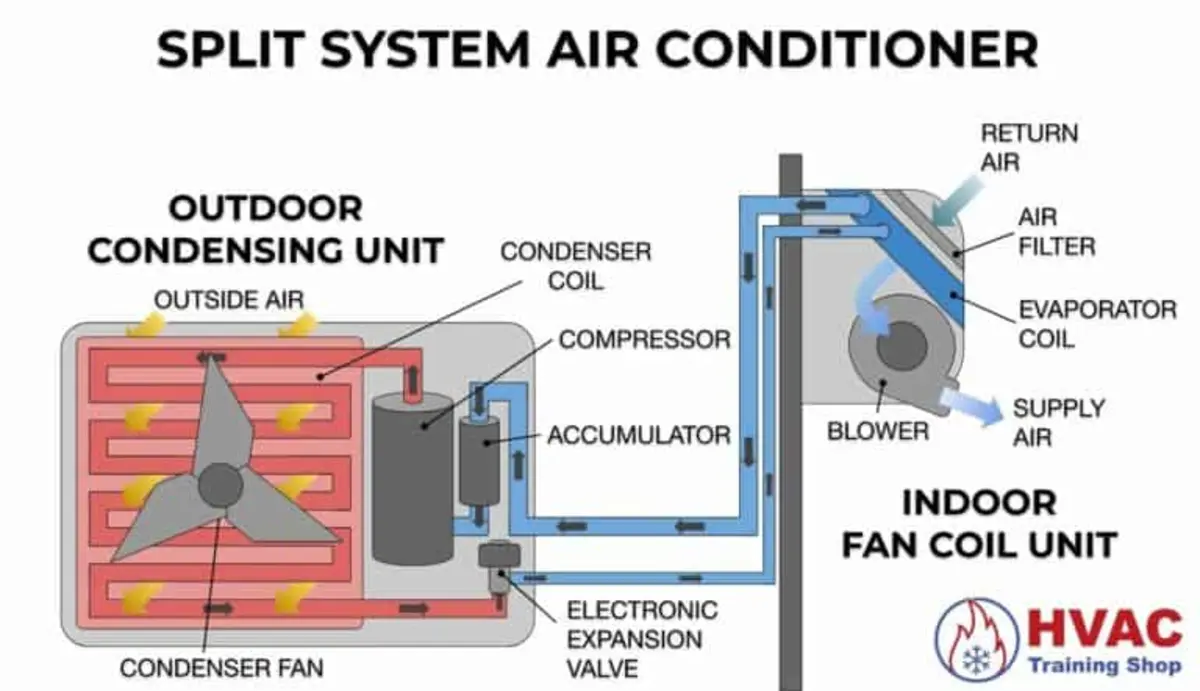Air Handler vs Condenser: Everything You Need to Know

Air Handler vs Condenser: Everything You Need to Know: When it comes to heating, ventilation, and air conditioning (HVAC) systems, two components stand out as essential to how the system works: the air handler and the condenser. While they work together to keep homes and buildings comfortable, they perform very different roles. Understanding the differences is critical for homeowners, property managers, and building professionals who want to make informed decisions about HVAC installation, upgrades, or maintenance.
What Is an Air Handler?
An air handler is the indoor unit that circulates conditioned air throughout a home or building. It is generally located indoors, commonly in a closet, attic, or utility room. The air handler contains:
- Blower (fan): Moves air through the ductwork.
- Evaporator coil: Works with refrigerant to cool or heat the air.
- Air filters: Capture dust, pollen, and contaminants for cleaner air.
Some air handlers also include electric heating elements or humidifiers, depending on the system design. The key point: the air handler doesn’t generate cooling or heating on its own—it distributes the conditioned air created by other components.
What Is a Condenser?
The condenser is the outdoor unit, usually located beside a house or on a building’s roof. It functions to either release or capture heat, depending on whether the system is set to cooling or heating. The condenser contains:
- Compressor: Pumps refrigerant through the system.
- Condenser coil: Releases heat to the outside air during cooling.
- Fan: Helps expel heat from the coil.
When in cooling mode, the condenser’s job is to move heat out of the building. When in heating mode (for a heat pump system), it reverses operation—drawing heat from the outside air and moving it indoors.
How Do They Work Together?
Think of the air handler and condenser as teammates. The condenser manages the transfer of heat, while the air handler makes sure the conditioned air is delivered to every room. Here’s how the process flows:
1. The condenser compresses and circulates refrigerant.
2. The refrigerant collects heat from inside the structure through the evaporator coil within the air handler.
3. The condenser releases that heat outside.
4. The air handler’s blower pushes cooled or heated air through the ducts to maintain indoor comfort.
Without one, the other can’t function. Both are required for a complete central air conditioning or heat pump system.
Key Differences Between Air Handler and Condenser
| Feature | Air Handler (Indoor) | Condenser (Outdoor) |
| —————- | ————————————— | ————————————- |
| Location | Inside (closet, attic, mechanical room) | Outside (ground level or rooftop) |
| Primary Function | Circulates conditioned air | Transfers heat in/out of the building |
| Main Components | Blower, evaporator coil, filters | Compressor, condenser coil, fan |
| Comfort Role | Distributes air | Creates heating or cooling effect |
Why Understanding the Difference Matters
For homeowners and building managers, knowing the difference between these two components makes it easier to:
Troubleshoot issues: Strange noises inside may point to the air handler; outdoor buzzing may indicate a condenser problem.
Plan for replacement: Air handlers often last 10–15 years; condensers have a similar lifespan, but each may require separate servicing or upgrades.
Improve efficiency: Matching the right air handler with the right condenser ensures peak performance and energy savings.
Budget better: A failing condenser is typically more expensive to replace than an air handler due to the compressor’s cost.
Practical Advice for Homes and Buildings
1. Regular Maintenance Is Essential
Change filters in the air handler every 1–3 months.
Keep the condenser free from clutter, such as dirt, leaves, or plant growth.
2. Sizing and Compatibility Matter
Always pair an air handler and condenser that are designed to work together. A mismatch can reduce efficiency and shorten system life.
3. Energy Efficiency Upgrades Pay Off
High-efficiency condensers with variable-speed compressors can cut energy use significantly.
Air handlers with ECM (electronically commutated motors) provide quieter, more efficient airflow.
4. Think Long-Term
For large buildings, consider modular air handling units (AHUs) and rooftop condensers that can scale with future needs.
For homes, investing in a properly matched system can improve comfort and reduce operating costs.
Final Thoughts
In every central HVAC system, the air handler and condenser are the core players. The air handler distributes conditioned air throughout the building, while the condenser manages the main process of heat exchange. By understanding what each unit does, property owners and building professionals can make smarter choices about installation, maintenance, and upgrades.
Whether you’re looking at a single-family home or a commercial building, keeping both components in top shape is the key to year-round comfort and efficiency.
AC service in South Jakarta
Looking for reliable service ac jakarta selatan? Professional technicians offer fast, efficient solutions for residential and commercial air conditioning needs. Whether it’s routine maintenance, deep cleaning, freon refill, or full installation, trusted providers like Alif Jaya Teknik and ACnusaCare deliver high-quality service with guaranteed results. They cover various AC types—split, cassette, portable, and central units—ensuring optimal performance and energy efficiency. With 24/7 availability and transparent pricing, these services prioritize customer comfort and satisfaction. From Pesanggrahan to Tebet, South Jakarta residents can enjoy cool, clean air thanks to expert ACjakarta care tailored to local climate demands.



